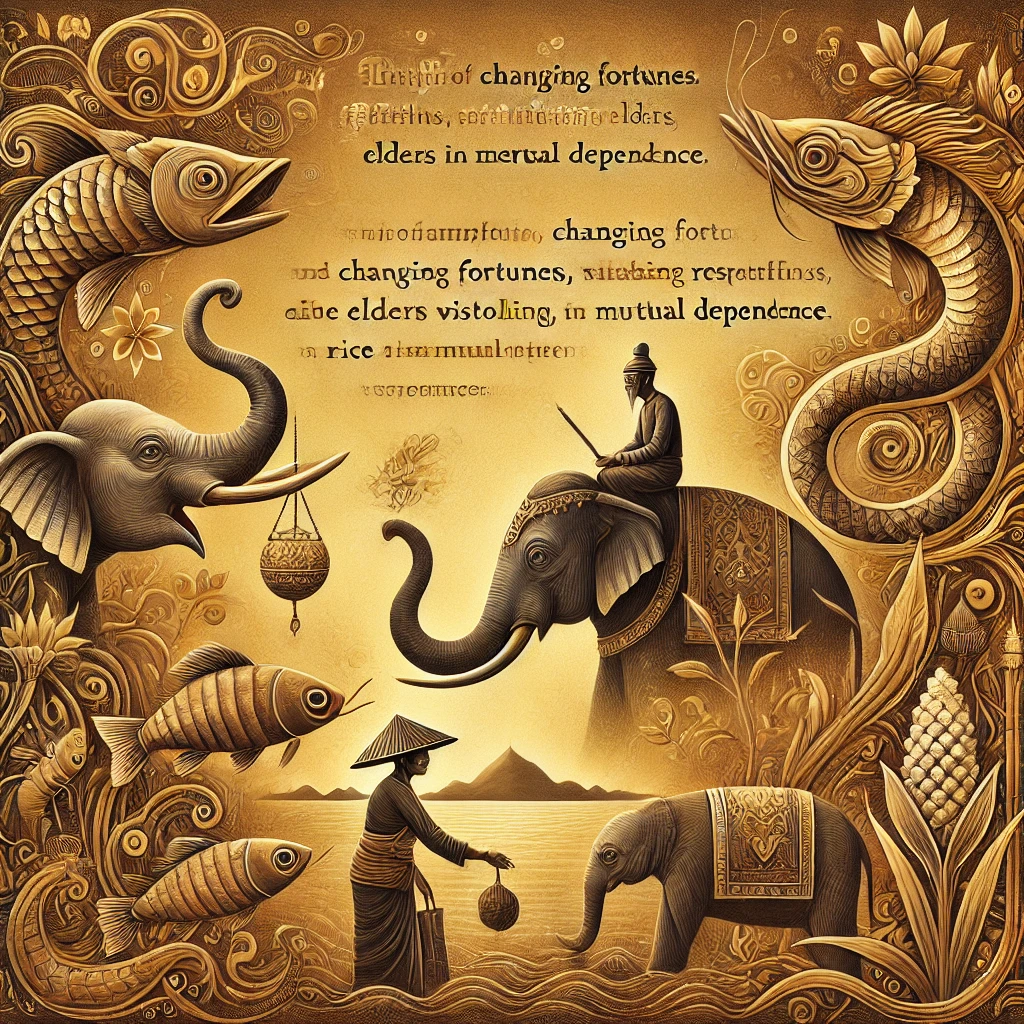Khmer proverbs, known as សុភាសិតខ្មែរ (sophaaset Khmae), are more than just quaint sayings; they are deeply woven into the fabric of Cambodian culture and communication. These concise expressions encapsulate generations of wisdom, reflecting societal values, offering guidance, and adding colour to everyday language. Understanding them provides invaluable insight into the Cambodian worldview, making them essential for anyone seeking a deeper connection with the culture or language.
The Significance of Proverbs in Cambodian Daily Life
In Cambodia, proverbs are not confined to historical texts. They frequently surface in daily conversations, used by people of all ages, though perhaps most notably by elders. They serve multiple purposes:
- Teaching Morals: Parents and elders use proverbs to instill values like diligence, respect, and honesty in children.
- Giving Advice: They offer practical wisdom for navigating complex social situations or making decisions.
- Making Observations: Proverbs provide a concise way to comment on human nature or the state of affairs.
- Resolving Conflict: Sometimes, a well-placed proverb can gently correct behaviour or mediate a disagreement without direct confrontation.
- Strengthening Community: Shared understanding of these sayings fosters a sense of cultural identity and continuity.
Famous Khmer Proverbs and Their Meanings
Accuracy is key when interpreting proverbs, as literal translations often miss the deeper cultural context. Here are a few well-known examples:
- សុភាសិត (Sophaaset): ចេះដប់មិនស្មើប្រសប់មួយ
- Transliteration: Cheh dop min smae prasop muoy.
- Literal Translation: Knowing ten things isn’t equal to being skilled in one.
- Meaning: This proverb emphasizes the value of mastery and expertise over superficial knowledge in many areas. It champions specialization and deep skill.
- សុភាសិត (Sophaaset): ទឹកឡើងត្រីស៊ីស្រមោច ទឹកហោចស្រមោចស៊ីត្រី
- Transliteration: Teuk laeung trey sii sramaoch, teuk haoch sramaoch sii trey.
- Literal Translation: When the water rises, fish eat ants; when the water recedes, ants eat fish.
- Meaning: This powerful proverb speaks to the impermanence of fortune and power. Circumstances change, and roles can be reversed. It advises humility in good times and patience in bad times, reminding us that everyone has their turn.
- សុភាសិត (Sophaaset): ដំរីស្លាប់យកចង្កូម ដំរីរស់យកខ្នាយ
- Transliteration: Damrei slap yok changkoum, damrei ros yok khnay.
- Literal Translation: A dead elephant, take the tusks; a live elephant, take the ivory (often interpreted as ‘use its strength/labour’). Note: The second part can be interpreted differently, sometimes relating to using living resources.
- Meaning: Find value in things whether they are present or past, functional or residual. It encourages resourcefulness and seeing the utility or worth in different states or situations.
- សុភាសិត (Sophaaset): សំណាបយោងដី ស្រីយោងប្រុស
- Transliteration: Samnap young dey, srey young bros.
- Literal Translation: Rice seedlings depend on the soil, women depend on men.
- Meaning: This reflects traditional views on gender roles and interdependence within a family structure. While societal views evolve, this proverb offers insight into historical social expectations. For language learners, it’s important to understand such proverbs reflect cultural history, even if modern interpretations or applications differ.
How Proverbs Reflect Cambodian Values and Traditions
Khmer proverbs are a mirror reflecting core cultural values:
- Respect for Elders: Many proverbs emphasize listening to the advice of older, more experienced individuals.
- Community and Harmony: Sayings often promote cooperation, patience, and avoiding conflict.
- Karma and Consequences: The idea that actions have repercussions is a recurring theme.
- Pragmatism and Resourcefulness: Proverbs frequently advise practical approaches to life and making the most of situations.
- Importance of Education and Skill: As seen in “Cheh dop min smae prasop muoy,” acquiring useful abilities is highly valued.
Khmer Idioms in Social Situations
While proverbs (sophaaset) typically offer moral or practical wisdom, Cambodians also use idioms (សំណួនវ៉ែន – samnuon vaen or ភាសាន័យ – pheasaa ney). These are figurative expressions whose meaning isn’t deducible from the literal words. For example:
- Idiom: ធ្វើត្រីធ្វើម្ហូប (tveu trey tveu mhoup) – Literally “make fish, make food,” but idiomatically means to do something properly or thoroughly.
- Idiom: ចាប់ក្តាមដាក់ចង្អេរ (chab kdam dak chang’ae) – Literally “catch crabs and put them in a flat basket,” meaning trying to manage unruly or chaotic people/situations (like crabs scattering).
Understanding the distinction between proverbs (wisdom) and idioms (figurative language) is helpful, though both enrich the Khmer language.
The Role of Elders in Passing Down Oral Wisdom
Traditionally, elders – grandparents, senior monks, and community leaders – have been the primary custodians and transmitters of this oral wisdom. Through storytelling around the hearth, guidance during daily tasks, or teachings in the pagoda, they embed these proverbs into the minds of younger generations. This role reinforces their respected position in society as holders of experience and cultural knowledge.
How Younger Generations Use and Adapt Traditional Proverbs
In contemporary Cambodia, the use of proverbs is evolving.
- Continued Use: Many proverbs remain relevant and are still used, particularly those emphasizing universal values like diligence or patience.
- Media Influence: Proverbs appear in songs, movies, and educational materials, keeping them in circulation.
- Adaptation: While some proverbs reflecting outdated social norms (like specific gender roles) might be used less frequently or ironically, the structure of proverbial wisdom endures.
- New Sayings: Modern life may inspire new concise sayings, often spread through social media, mimicking the function of traditional proverbs.
- Potential Loss: As lifestyles change and exposure to global media increases, there’s a concern among some that the nuances and regular use of older, complex proverbs might decline if not actively preserved.
Conclusion
Khmer proverbs and sayings are vital threads in the rich tapestry of Cambodian culture. They offer profound insights into the nation’s history, values, and philosophy. For learners of the Khmer language, engaging with sophaaset goes beyond vocabulary; it opens a door to understanding the Cambodian heart and mind. While the way they are used may adapt with time, their essence as carriers of wisdom ensures their continued relevance in Cambodian life.



